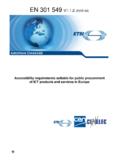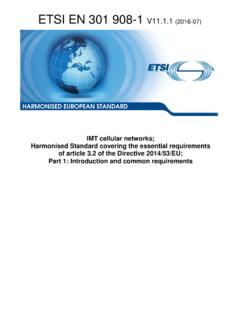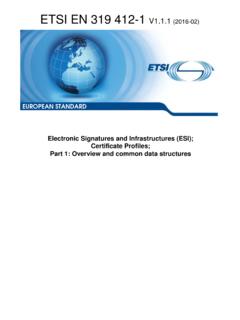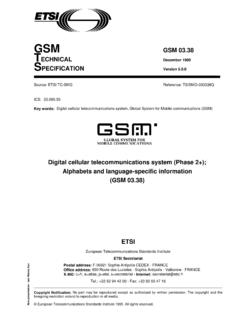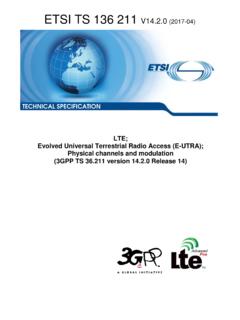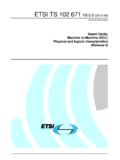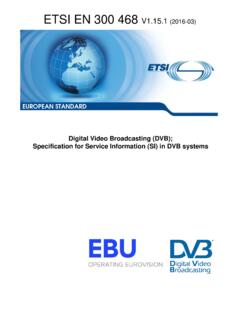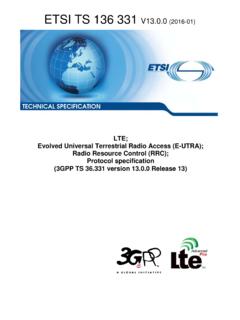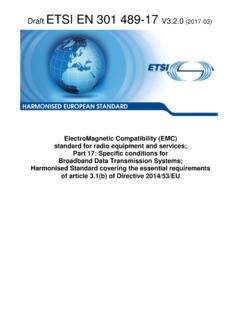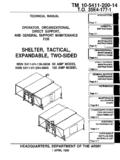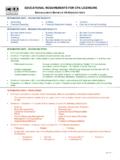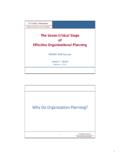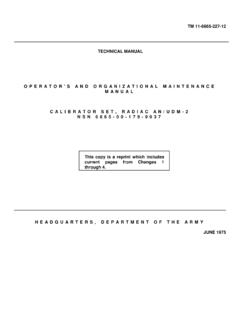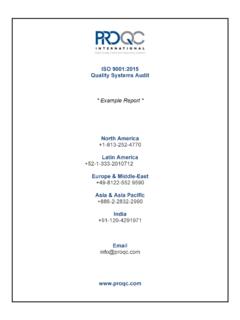Transcription of ES 201 468 - V1.6.1 - Additional ElectroMagnetic ...
1 ETSI ES 201 468 (2016-07) Additional ElectroMagnetic Compatibility (EMC) requirements and resistibility requirements for telecommunications equipment for enhanced availability of service in specific applications ETSI STANDARD ETSI ETSI ES 201 468 (2016-07) 2 Reference RES/ERM-EMC-348 Keywords EMC, management, network, power supply, switching, testing, transmission ETSI 650 Route des Lucioles F-06921 Sophia Antipolis Cedex - FRANCE Tel.: +33 4 92 94 42 00 Fax: +33 4 93 65 47 16 Siret N 348 623 562 00017 - NAF 742 C Association but non lucratif enregistr e la Sous-Pr fecture de Grasse (06) N 7803/88 Important notice The present document can be downloaded from: The present document may be made available in electronic versions and/or in print. The content of any electronic and/or print versions of the present document shall not be modified without the prior written authorization of ETSI. In case of any existing or perceived difference in contents between such versions and/or in print, the only prevailing document is the print of the Portable Document Format (PDF) version kept on a specific network drive within ETSI Secretariat.
2 Users of the present document should be aware that the document may be subject to revision or change of status. Information on the current status of this and other ETSI documents is available at If you find errors in the present document, please send your comment to one of the following services: Copyright Notification No part may be reproduced or utilized in any form or by any means, electronic or mechanical, including photocopying and microfilm except as authorized by written permission of ETSI. The content of the PDF version shall not be modified without the written authorization of ETSI. The copyright and the foregoing restriction extend to reproduction in all media. European Telecommunications Standards Institute 2016. All rights reserved. DECTTM, PLUGTESTSTM, UMTSTM and the ETSI logo are Trade Marks of ETSI registered for the benefit of its Members. 3 GPPTM and LTE are Trade Marks of ETSI registered for the benefit of its Members and of the 3 GPP Organizational Partners.
3 GSM and the GSM logo are Trade Marks registered and owned by the GSM Association. ETSI ETSI ES 201 468 (2016-07) 3 Contents Intellectual Property Rights .. 5 Foreword .. 5 Modal verbs terminology .. 5 Introduction .. 5 1 Scope .. 6 2 References .. 6 Normative references .. 6 Informative references .. 7 3 Definitions and abbreviations .. 8 Definitions .. 8 Abbreviations .. 10 4 General operational conditions .. 11 General requirements .. 11 Equipment configuration .. 11 Exercising equipment .. 11 Laboratory environment .. 11 5 General performance criteria for immunity tests .. 12 General requirements .
4 12 Performance criterion A .. 12 Performance criterion B .. 12 Performance criterion C .. 12 6 Immunity: test methods .. 13 General .. 13 Electrostatic discharge .. 13 Electrical fast transients/burst .. 13 Surges .. 13 Outdoor signal line ports .. 13 Indoor signal line ports .. 13 AC power line ports .. 13 Immunity to continuous conducted signals .. 13 AC power supply port .. 13 DC power supply interface port .. 14 Signal line port .. 14 Immunity to radiated ElectroMagnetic fields .. 14 Immunity to power supply disturbances: AC and DC ports .. 14 Test of immunity to low frequency disturbances: AC ports .. 14 Test of immunity to low frequency disturbances: DC ports .. 14 Immunity to interference from permanent power induction .. 14 Power frequency magnetic fields .. 14 7 Resistibility: test methods.
5 15 Electrostatic discharge .. 15 Lightning .. 15 Power induction and earth potential rise .. 15 Mains power contact .. 15 8 Emission: test methods and limits .. 15 9 Immunity requirements .. 15 General requirements .. 15 Equipment operating in telecommunication centres .. 17 Telecommunication centres, level 17 Telecommunication centres, enclosure port, level 1 .. 17 Telecommunication centres, ports for outdoor signal lines, level 1 .. 17 ETSI ETSI ES 201 468 (2016-07) 4 Telecommunication centres, ports for indoor signal lines, level 1 .. 17 Telecommunication centres, AC power ports, level 1 .. 18 Telecommunication centres, DC power ports, level 1 .. 18 Telecommunication centres, level 18 Telecommunication centres, enclosure port, level 2 .. 18 Telecommunication centres, ports for outdoor signal lines, level 2.
6 19 Telecommunication centres, ports for indoor signal lines, level 2 .. 19 Telecommunication centres, AC power ports, level 2 .. 20 Telecommunication centres, DC power ports, level 2 .. 21 Equipment operating in locations other than telecommunication centres .. 21 Equipment operating in locations other than telecommunication centres, level 1 .. 21 Other than telecommunication centres, enclosure port, level 1 .. 21 Other than telecommunication centres, ports for outdoor signal lines, level 1 .. 22 Other than telecommunication centres, ports for indoor signal lines, level 1 .. 22 Other than telecommunication centres, AC power ports, level 1 .. 22 Other than telecommunication centres, DC power ports, level 1 .. 22 Equipment operating in locations other than telecommunication centres, level 2 .. 23 Other than telecommunication centres, enclosure port, level 2 .. 23 Other than telecommunication centres, ports for outdoor signal lines, level 2.
7 24 Other than telecommunication centres, ports for indoor signal lines, level 2 .. 25 Other than telecommunication centres, AC power ports, level 2 .. 26 Other than telecommunication centres, DC power ports, level 2 .. 26 10 Resistibility requirements .. 27 Annex A (normative): Surges: test method for ports of signal lines remaining within the building .. 28 General .. 28 Test set-up for ports with ISDN interface .. 28 Annex B (informative): Evaluation of test results .. 30 Annex C (informative): Guidance for the product specific operational conditions and performance criteria .. 32 General .. 32 Operational conditions and performance criteria during EMC tests .. 32 General considerations .. 32 Operational conditions during EMC tests .. 33 Performance criteria during EMC tests .. 33 Examples of specific performance criteria .. 34 Example of Additional performance criteria (and further details of requirements ) for "primary rate multiple access" equipment.
8 34 Annex D (informative): Bibliography .. 35 History .. 36 ETSI ETSI ES 201 468 (2016-07) 5 Intellectual Property Rights IPRs essential or potentially essential to the present document may have been declared to ETSI. The information pertaining to these essential IPRs, if any, is publicly available for ETSI members and non-members, and can be found in ETSI SR 000 314: "Intellectual Property Rights (IPRs); Essential, or potentially Essential, IPRs notified to ETSI in respect of ETSI standards", which is available from the ETSI Secretariat. Latest updates are available on the ETSI Web server ( ). Pursuant to the ETSI IPR Policy, no investigation, including IPR searches, has been carried out by ETSI. No guarantee can be given as to the existence of other IPRs not referenced in ETSI SR 000 314 (or the updates on the ETSI Web server) which are, or may be, or may become, essential to the present document. Foreword This ETSI Standard (ES) has been produced by ETSI Technical Committee ElectroMagnetic compatibility and Radio spectrum Matters (ERM).
9 The present document defines the EMC requirements of telecommunication network equipment for an increased reliability and the resistibility requirements . Modal verbs terminology In the present document "shall", "shall not", "should", "should not", "may", "need not", "will", "will not", "can" and "cannot" are to be interpreted as described in clause of the ETSI Drafting Rules (Verbal forms for the expression of provisions). "must" and "must not" are NOT allowed in ETSI deliverables except when used in direct citation. Introduction The present document defines EMC requirements for telecommunications equipment to guarantee enhanced availability of service in specific applications. Resistibility requirements are also defined with reference to ITU-T K series recommendations. ETSI ETSI ES 201 468 (2016-07) 6 1 Scope The present document covers the emission, immunity and resistibility requirements for telecommunications equipment where higher performance is required by operators to guarantee enhanced availability of service in specific applications.
10 The environments considered in the present document are defined in ETSI TR 101 651 [ ] and are: - telecommunication centres (classes 1 and 2 of ETSI TR 101 651 [ ]); - locations other than telecommunication centres (classes 3 and 4 of ETSI TR 101 651 [ ]). Data centres and similar facilities are also considered telecommunication centres, where they are within a dedicated room with servers, storage devices and associated telecommunication equipment. Considering that all kinds of equipment are not equally important, two equipment categories and associated EMC requirements are introduced and are designated as: - level 1 (see tables in clauses to and to ); - level 2 (see tables in clauses to and to ); the latter containing the more demanding requirements . The appropriate level should be chosen by the operator considering the consequences of failure of the equipment which may lead to impaired function, loss of service, failure to meet contractual obligations or bad publicity and loss of reputation.
